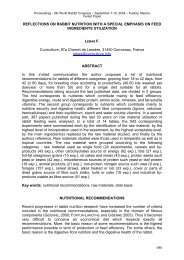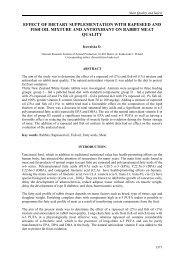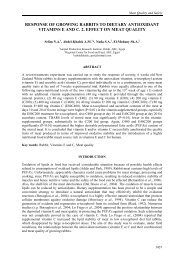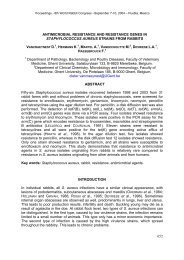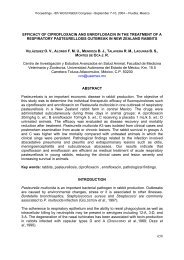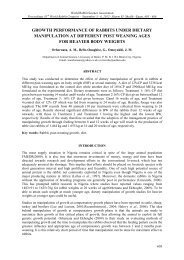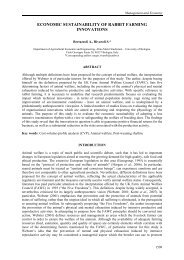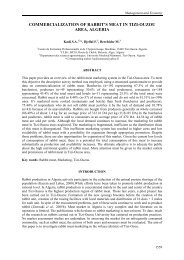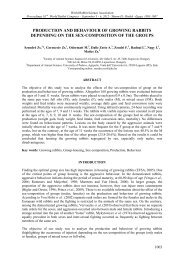characterization of traditional rabbit breeding system used
characterization of traditional rabbit breeding system used
characterization of traditional rabbit breeding system used
Create successful ePaper yourself
Turn your PDF publications into a flip-book with our unique Google optimized e-Paper software.
9 th World Rabbit Congress – June 10-13, 2008 – Verona – Italy<br />
b) Reproduction management<br />
In the improved livestock <strong>system</strong>, there is a good understanding <strong>of</strong> reproduction management, since<br />
there's a separation <strong>of</strong> <strong>breeding</strong> animals and their progeny. The does are introduced into the cage <strong>of</strong> the<br />
buck only at the time <strong>of</strong> the mating. The female age at the first kindly is four months, and five months<br />
in male. The number <strong>of</strong> pops by kindling varies from four to twelve born alive, the average age at<br />
weaning is 25 days and the weaning weight varies from 300 to 500 g. The most frequent reproduction<br />
<strong>system</strong> <strong>used</strong> is mating during the first week post-partum or the second week after weaning.<br />
c) Feeding <strong>system</strong>s<br />
Food is based on concentrate with a frequency <strong>of</strong> daily rations. In addition, the feed intake could be<br />
insured by the use <strong>of</strong> dry fodder.<br />
d) Health state<br />
Concerning health status in the improved <strong>system</strong>, there is a sanitary follow-up followed by the<br />
veterinarian and the use <strong>of</strong> disinfectants in the water.<br />
e) Marketing <strong>system</strong><br />
The price <strong>of</strong> animals differs from the type <strong>of</strong> animals whether it intended for <strong>breeding</strong> or for<br />
consumption. The sale <strong>of</strong> the production is done directly to markets or direct sale <strong>of</strong> live animals.<br />
1508<br />
CONCLUSIONS<br />
The study showed the variability <strong>of</strong> the local livestock <strong>system</strong>s encountered in the south-west <strong>of</strong><br />
Tunisia. These types <strong>of</strong> farms have no technical assistance, and there is no strategy for their<br />
development. To initiate a program <strong>of</strong> conservation and improvement <strong>of</strong> <strong>traditional</strong> livestock we<br />
recommend: completing the inventory through the Tunisian territory in order to ascertain the current<br />
situation in a way as accurate as possible; improving the productivity <strong>of</strong> this by improving the<br />
<strong>breeding</strong> techniques suitable for the environment; supervision <strong>of</strong> farmers in organized units such as<br />
associations and organizations ensuring products collection and services supply (feed and medicines).<br />
REFERENCES<br />
Arnold J., Rechambeau H. de. 1983. Inventaire des races menaces et des actions de conservation: les animaux de basse-cour.<br />
Ethnozootechnie, 33.<br />
Boulet G. 1999. A programme for the inventory, characterisation, evaluation, conservation and utilisation <strong>of</strong> European <strong>rabbit</strong><br />
(Oryctolagus cuniculus) genetic <strong>rabbit</strong>. AGRI, (25), 57-70.<br />
FAO 2001. L’état des ressources zoogénétiques pour l'alimentation et l'agriculture dans le monde. Ed FAO, 2-5.<br />
Finzi A., Scapani, Tani A. 1988. Les élevages cunicoles dans la region du Nefzaoua en Tunisie. Rivista di Agricoltura<br />
subtropicale e tropicale, LXXXII (1-2).





